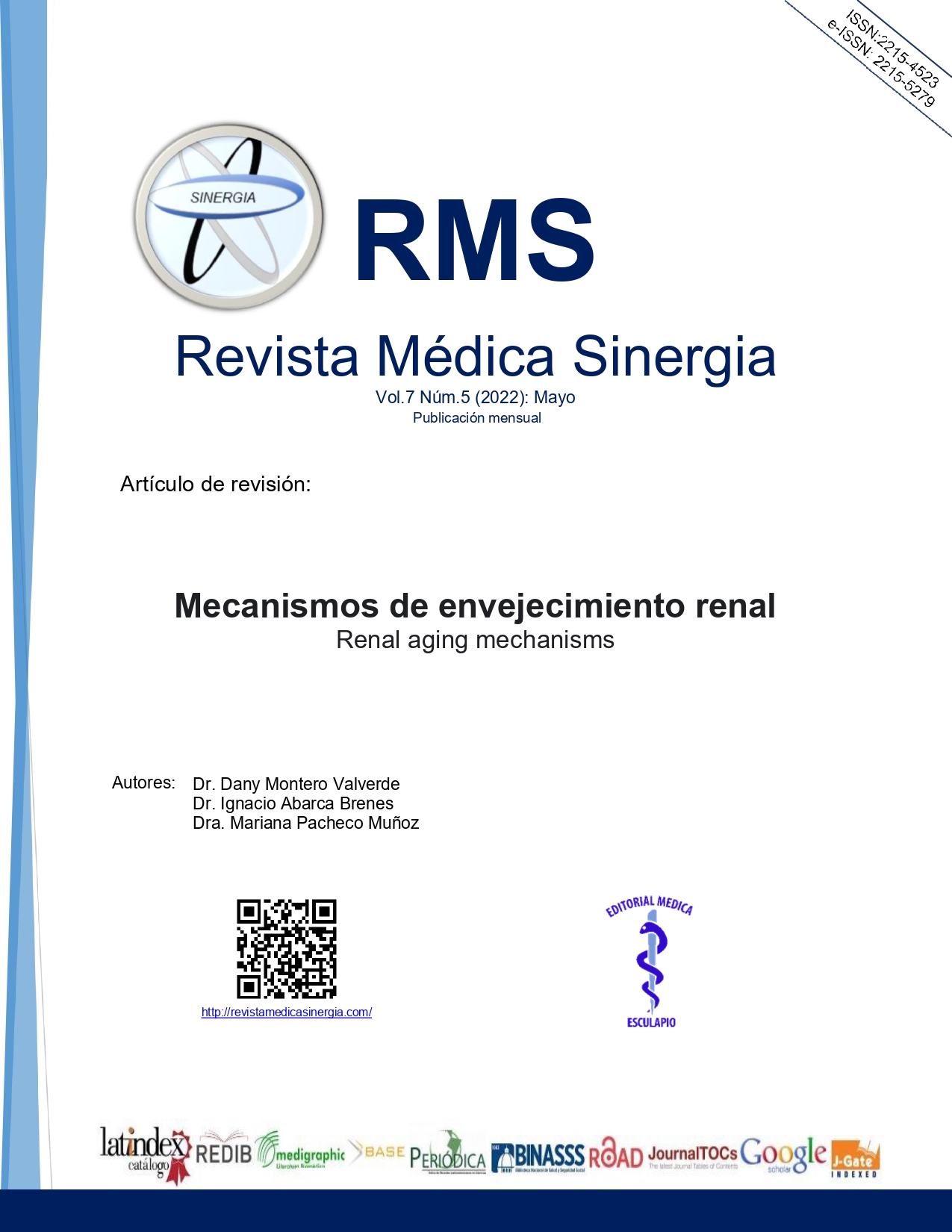Abstract
The kidneys are one of the organs that undergoes the most changes during aging. There are a series of mechanisms involved in the renal senescence process that explain the structural, functional and molecular changes that occur intrinsically in this organ. One of the most studied is the Klotho gene, whose decrease favors harmful processes that lead to arteriosclerosis and the progression of permanent kidney damage. Other mechanisms detailed in this review include fibroblast growth factor 23, cellular senescence, telomere shortening, chronic inflammation, and Wnt signaling that is often overexpressed during aging. Understanding these mechanisms will favor the implementation of different interventions in the future to stop or slow down the fibrosis and sclerosis that develops in older adults with increasing age.
Keywords
References
O’Sullivan ED, Hughes J, Ferenbach DA. Renal aging: Causes and consequences. J Am Soc Nephrol [Internet]. 2017;28(2):407–20. doi: http://dx.doi.org/10.1681/ASN.2015121308
Li Z, Wang Z. Aging kidney and aging-related disease. Adv Exp Med Biol [Internet]. 2018;1086:169–87. doi: http://dx.doi.org/10.1007/978-981-13-1117-8_11
Kuro-O M. The Klotho proteins in health and disease. Nat Rev Nephrol [Internet]. 2019;15(1):27–44. doi: http://dx.doi.org/10.1038/s41581-018-0078-3
Buchanan S, Combet E, Stenvinkel P, Shiels PG. Klotho, aging, and the failing kidney. Front Endocrinol (Lausanne) [Internet]. 2020;11. doi: http://dx.doi.org/10.3389/fendo.2020.00560
Drew DA, Katz R, Kritchevsky S, Ix JH, Shlipak MG, Newman AB, et al. Fibroblast growth factor 23: A biomarker of kidney function decline. Am J Nephrol [Internet]. 2018;47(4):242–50. doi: http://dx.doi.org/10.1159/000488361
Wei S-Y, Pan S-Y, Li B, Chen Y-M, Lin S-L. Rejuvenation: Turning back the clock of aging kidney. J Formos Med Assoc [Internet]. 2020;119(5):898–906. doi: http://dx.doi.org/10.1016/j.jfma.2019.05.020
Schmitt R, Melk A. Molecular mechanisms of renal aging. Kidney Int [Internet]. 2017;92(3):569–79. doi: http://dx.doi.org/10.1016/j.kint.2017.02.036
Valentijn FA, Falke LL, Nguyen TQ, Goldschmeding R. Cellular senescence in the aging and diseased kidney. J Cell Commun Signal [Internet]. 2018;12(1):69–82. doi: http://dx.doi.org/10.1007/s12079-017-0434-2
Gekle M. Kidney and aging — A narrative review. Exp Gerontol [Internet]. 2017;87:153–5. doi: http://dx.doi.org/10.1016/j.exger.2016.03.013
Kidir V, Aynali A, Altuntas A, Inal S, Aridogan B, Sezer MT. Telomerase activity in patients with stage 2–5D chronic kidney disease. Nefrologia [Internet]. 2017;37(6):592–7. doi: http://dx.doi.org/10.1016/j.nefro.2017.03.025
Patel S, Rauf A, Khan H, Abu-Izneid T. Renin-angiotensin-aldosterone (RAAS): The ubiquitous system for homeostasis and pathologies. Biomed Pharmacother [Internet]. 2017;94:317–25. doi: http://dx.doi.org/10.1016/j.biopha.2017.07.091
Choudhury D, Levi M. Kidney aging--inevitable or preventable? Nat Rev Nephrol [Internet]. 2011;7(12):706–17. doi: http://dx.doi.org/10.1038/nrneph.2011.104
Paz Ocaranza M, Riquelme JA, García L, Jalil JE, Chiong M, Santos RAS, et al. Counter-regulatory renin-angiotensin system in cardiovascular disease. Nat Rev Cardiol [Internet]. 2020;17(2):116–29. doi: http://dx.doi.org/10.1038/s41569-019-0244-8
Li XC, Zhang J, Zhuo JL. The vasoprotective axes of the renin-angiotensin system: Physiological relevance and therapeutic implications in cardiovascular, hypertensive and kidney diseases. Pharmacol Res [Internet]. 2017;125:21–38. doi: http://dx.doi.org/10.1016/j.phrs.2017.06.005
Yang T, Xu C. Physiology and pathophysiology of the intrarenal renin-angiotensin system: An update. J Am Soc Nephrol [Internet]. 2017;28(4):1040–9. doi: http://dx.doi.org/10.1681/ASN.2016070734
Wang Y, Zhou CJ, Liu Y. Wnt signaling in kidney development and disease. Prog Mol Biol Transl Sci [Internet]. 2018;153:181–207. doi: http://dx.doi.org/10.1016/bs.pmbts.2017.11.019
Zuo Y, Liu Y. New insights into the role and mechanism of Wnt/β-catenin signalling in kidney fibrosis: Wnt/β-catenin and kidney fibrosis. Nephrology (Carlton) [Internet]. 2018;23 Suppl 4:38–43. doi: http://dx.doi.org/10.1111/nep.13472
Li Z, Zhou L, Wang Y, Miao J, Hong X, Hou FF, et al. (pro)renin receptor is an amplifier of Wnt/β-catenin signaling in kidney injury and fibrosis. J Am Soc Nephrol [Internet]. 2017;28(8):2393–408. doi: http://dx.doi.org/10.1681/ASN.2016070811
Chen D, Xie R, Shu B, Landay AL, Wei C, Reiser J, et al. Wnt signaling in bone, kidney, intestine, and adipose tissue and interorgan interaction in aging. Ann N Y Acad Sci [Internet]. 2019;1442(1):48–60. doi: http://dx.doi.org/10.1111/nyas.13945
Miao J, Liu J, Niu J, Zhang Y, Shen W, Luo C, et al. Wnt/β-catenin/RAS signaling mediates age-related renal fibrosis and is associated with mitochondrial dysfunction. Aging Cell [Internet]. 2019;18(5):e13004. doi: http://dx.doi.org/10.1111/acel.13004
Zhou G, Li J, Zeng T, Yang P, Li A. The regulation effect of WNT-RAS signaling in hypothalamic paraventricular nucleus on renal fibrosis. J Nephrol [Internet]. 2020;33(2):289–97. doi: http://dx.doi.org/10.1007/s40620-019-00637-8

This work is licensed under a Creative Commons Attribution-NonCommercial 4.0 International License.
Copyright (c) 2022 Array


